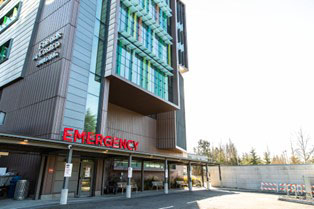Provider News
Seattle Children’s Emergency Department and Hospital Capacity Updates
February 7, 2024
Viral Illness Trends and Emergency Department and Hospital Volumes

- ED Volumes: Our ED volumes have been stable over the last several weeks with lower volumes from our 2023 peaks but well above previous years and on track to match our pre-pandemic volumes.
- Influenza: We are seeing stable and moderate positive rates. The trajectory of our region remains uncertain given national variability.
- RSV: Activity is past peak and continues to drop. However, RSV is still the second most frequent positive result in our local PCR testing.
- SARS-CoV-2: Activity continues to be elevated locally and globally, driven by the JN.1 variant, with levels elevated compared to December. Anecdotally, although ED visits are not high, the new variants are causing lots of new illness and first time COVID infections locally.
- Norovirus and Rotavirus: Norovirus activity remains high, which is typical for this time of the year with peaks typically in late winter. Rotavirus activity is spiking in the southern U.S., and we are monitoring.
How You Can Help
- Please continue to identify and manage lower-acuity complaints in outpatient settings, including urgent care, to help maintain ED capacity for higher-acuity concerns.
- Utilize our Healthcare Professionals site for Resources for Community Providers, including our Asthma algorithm, Bronchiolitis guidance document, COVID-19 Return to Sports algorithm, Acute Pharyngitis and Recurrent Pharyngitis
- Advise patient families to utilize our library of Barton Schmitt patient education handouts on hundreds of conditions including COVID-19, influenza and RSV.
- Before sending your patient to the ED, contact our Mission Control team with as much notice as possible at 206-987-8899. This helps us plan for your patient’s arrival. In appropriate instances, we may be able to directly admit your patient to the hospital or arrange an urgent ambulatory clinic visit in lieu of an ED visit.
- Please be aware that our inpatient PBMU has limited capacity for new patients. At this time, we are referring pediatric patients requiring psychiatric inpatient admission to appropriate facilities in Washington state, as needed.
- Help set realistic expectations about an ED visit for mental health and/or inpatient psychiatric admission with children, families, and partners.
- An ED visit for mental or behavioral health typically involves an evaluation to determine if the child needs an inpatient psychiatric admission or is appropriate to discharge home. Patients and families should be prepared for potentially longer wait times.
- Inpatient psychiatric capacity for pediatrics remains limited at Seattle Children’s and across Washington; we are asking all external partners to consider referring patients who need inpatient admission to all appropriate inpatient pediatric psychiatric facilities in Washington and consistently re-assess need for inpatient admission.
- An inpatient psychiatric admission is typically 5 to 10 days and focused on acute crisis stabilization. It is not a long-term placement.